Showing 25–36 of 96 results
-
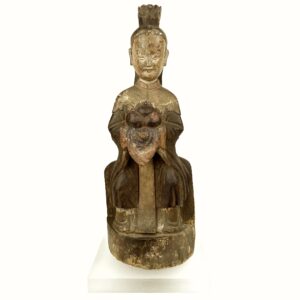
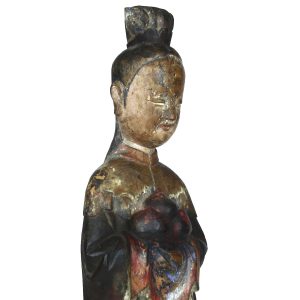
$595.00
H: 14” W: 6.25 D: 3.5” | FREE SHIPPING!
This delicately carved seated female attendant probably accompanied a religious image on a home altar. She holds an offering plate with three offerings of dumplings or pieces of fruit, possibly a peach trio, Chinese longevity symbols. A three-item offering is a pun for a group of three ancient coins known as tael a symbol of wealth and a wish for high status.
-
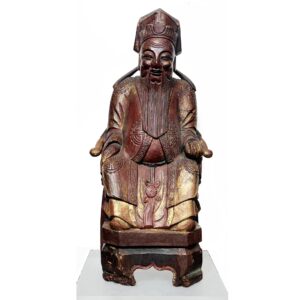
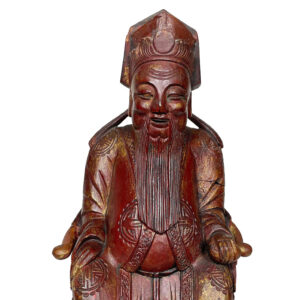
$745.00
H: 10.25” W: 4.75” D: 3.625” | FREE SHIPPING!
This beautifully carved God of Wealth (Caishen) is portrayed as are all Taoist deities as an authoritative figure, right hand firmly placed on his knee and left hand holding a tael. His outer robe has decorative borders down the front and carved coins at the shoulders, stomach, and an undergarment is gathered with a floral designed tasseled cord. His well-defined face with incised wrinkles and long beard has a benevolent expression with rounded cheeks and an open mouth, topped by an elaborate official’s hat with ribbon-like extensions. Very fittingly, it is painted with red and gold both associated with wealth.
-
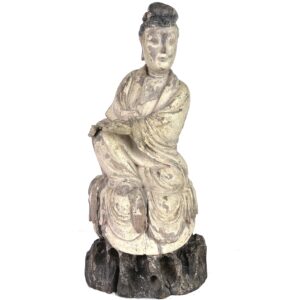
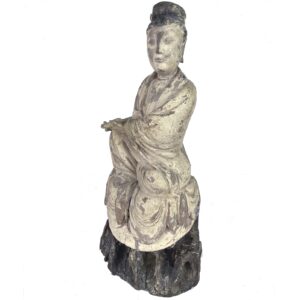
$1,550.00
H: 15.25″ W: 7.5″ D: 6.5″ |SHIPPING INFORMATION REQUIRED. CONTACT US AT 213-568-3030
Masterfully carved, this Guanyin has gentle curves thrusting her weight in opposing directions in a lyrical posture in lalitsana. Her refined right hand with gentle elongated fingers rests on her right knee and her left extends across her body to hold a scroll, symbolizing the Lotus Sutra, one of the Buddhist scriptures where her deeds and powers are enumerated or the Dharma which she constantly reads. Portrayed as a mature compassionate woman in serene repose, her delicate face has half-closed almond eyes, pursed lips, and full cheeks. Her hair is atop her head in a chignon and she wears a loose robe open at the chest and tied at the waist. The deeply carved folds of the robe and the patterns on the rocky outcrop on which she sits exemplify the artisan’s superior craftsmanship.
-
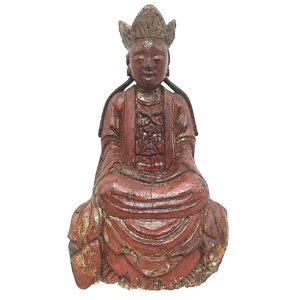
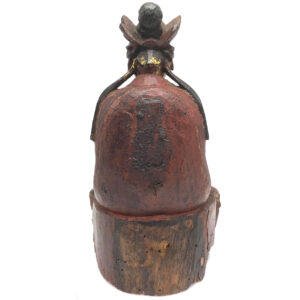
$425.00
H: 9.75″ W: 5.625″ D: 3.75″ | FREE SHIPPING!
In this provincial carving made for personal use, Guanyin the Bodhisattva of Compassion who hears the cries of all beings, sits in meditation with flowing robes, half closed eyes, a round face and a slight smile, the embodiment of loving-kindness. Her 5-lobed crown is centered with radiating lines symbolizing the aureole of the Amitabha Buddha of Infinite Light.
-
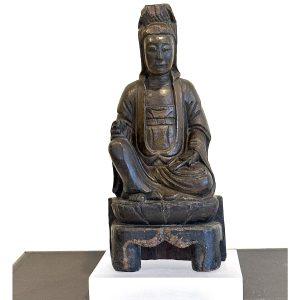
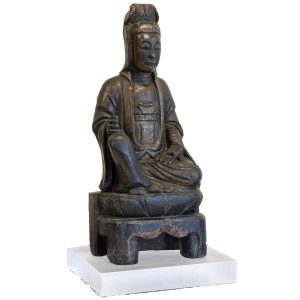
$515.00
Ht: 10.75″ W: 5.5″ D: 4.5″ | FREE SHIPPING
This dark wood carving is a Guanyin manifestation called “white hooded,” “white clad” or “white robed” Guanyin derived from the many paintings where she is clad in white. Although wood carvings usually portray her clothed in red, this finely carved version of her is covered in a thick lacquer coat that darkens naturally over time and darkens even more when honored on a home altar with daily prayers and offerings that include smoky candles and burning incense.
-
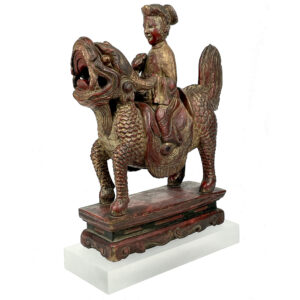
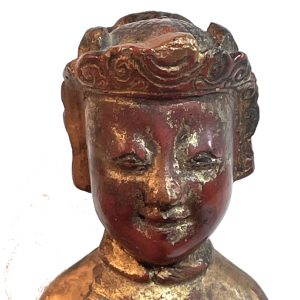
$875.00
H: 9.5” W: 2.25” D: 6.5” | FREE SHIPPING!
This remarkable and enchanting figurine is Guanyin on her mythical mount, the Hǒu the guardian master of the universe and model for righteousness and morality who symbolizes bringing forth peace and prosperity.The round orb in its mouth representing a pearl can be rubbed for good luck. It is one of our most unique and favorite Buddhist statues, mounted on a frosted acrylic stand.
-
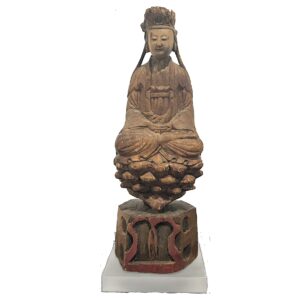
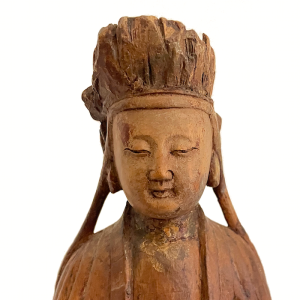
$695.00
H: 14.5” W: 5.5” D: 4.25” | FREE SHIPPING
Guanyin’s elegance, compassion and serenity are emphasized in this graceful antique provincial carving. Portrayed in meditation with flowing robes on a majestic three-tiered lotus throne she was designed for personal veneration in a home setting.
-
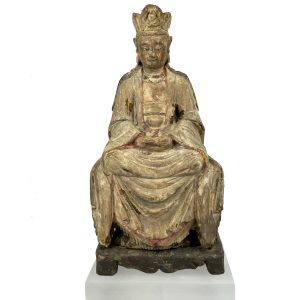
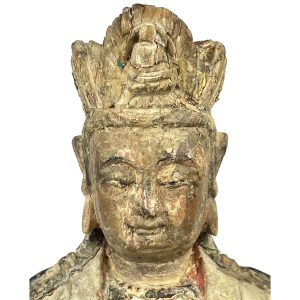
$1,300.00
H: 13.75” W: 7” D: 4.5” | FOR SHIPPING INFORMATION CONTACT US AT 213-568-3030
This delicately detailed Guanyin statue seated in meditation on a two-tiered backless throne has flowing braids, simple necklace, and voluminous robes indicate her regal status, while her pendulous ears, compassionate downcast eyes, serene contemplative expression, and calm smile symbolize her enlightened status. The image’s distinguishing feature is its deeply carved three-part diadem (crown) centered with a carved Amitabha Buddha on lotus throne surrounded by an aureole.
-
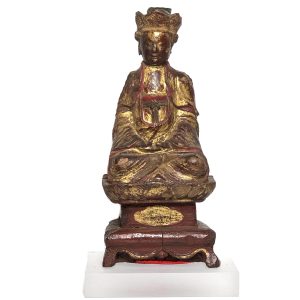
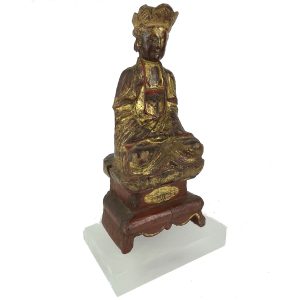
$495.00
Ht: 10.5” W: 5.5” D: 4” | FREE SHIPPING!
Guanyin is portrayed in this gilt and lacquer carving seated on a lotus in the lap in meditation mudra atop a decorative footed stand in elegantly draped robes. In thisregal form she wears a 5-lobe crown with a cross hatch design in the center while her hair rests atop her head in a bun encircled within the crown.
-
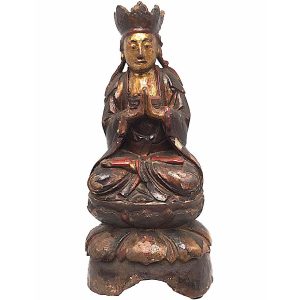
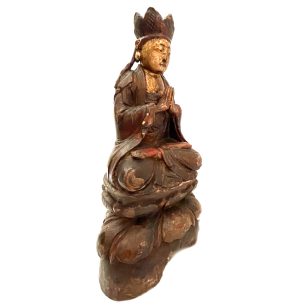
$475.00
H: 11.625″ W: 5.325″ D: 4.25″ | FREE SHIPPING!
Made for placement on a home altar, this small Guanyin sits in lotus position (padmasana) feet upward and exposed, hands clasped in anjali mudra of prayer, reverence, respect. With a full face and downcast eyes, she is depicted in modest provincial style with symbols of her bodhisattva status: a 5-lobed diadem, hair in a chignon, braids draping down her shoulders, and a flowing robe. Her pendulous ears are a sign of wisdom, her ability to hear the cries of sentient beings, and her spiritual awakening. It is covered with gilt as a sign of her enlightened status.
-
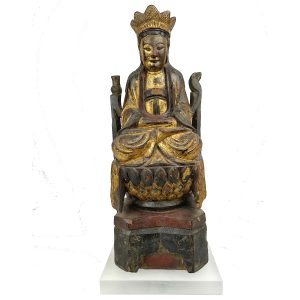
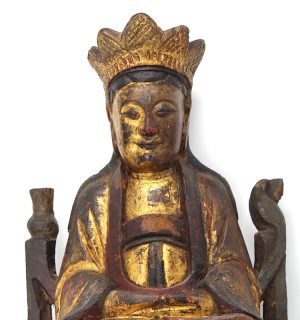
$1,450.00
H: 15.5″ W: 6″ D: 5.25″ | for shipping information contact us at 213-568-3030
In this elegant and vibrant carving Guanyin sits in meditation and feet in padmasana. Her beautiful, serene face is elegantly carved in contemplation with half-closed eyes and bud-shaped lips softly set in a welcoming and benign sweet smile. Her forehead is framed with soft curls and long hair drawn into chignon set behind her striated five-lobed crown and falling in knotted braids to her shoulders. Wearing elegant long flowing gilt and red robes, she sits on an open lotus with a vertical post at her sides; her sacred vial on her right and a parrot on the left. Antique carved i Guanyin statues with her symbols in this condition are quite wonderful and rare and impart a feeling of serenity to the environment around them.
-
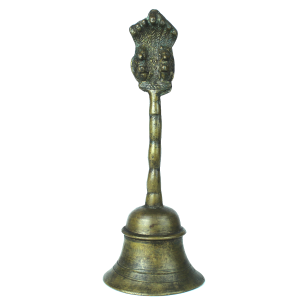
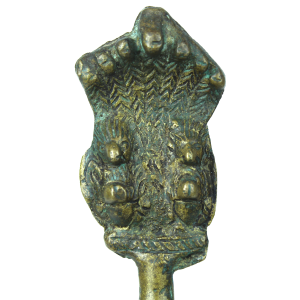
$295.00
H: 10” Dia: 3.75” | FREE SHIPPING!
This Hindu prayer bell was likely placed on a home or temple altar and in daily puja rituals. This simple yet elegant bell has a smooth and undecorated body with only incised parallel rings circling plain surfaces and is topped by a pair of Garudas sheltered by a hood of Nagas. Garuda, the mythical winged bird that is Vishnu’s mount, and Naga, a seven-headed hooded serpent, are natural enemies and when they are represented together, they symbolizes peace, a very appropriate adornment for the tranquility and serenity elicited by the pleasing sounds of a prayer bell.
Martin Lerner an Steven Kossak, The Lotus Transcendent: Indian and Southeast Asian Art from the Samuel Eilenberg Collection, Harry Abrams, New York, 1991.
End of content
End of content























